#the instructions. the payoff has begun!
Explore tagged Tumblr posts
Text
*shaking fist at sky* CLOOOOOOOWWWWWWNNNNNNNN
#edit: look at this post's reblog#WYM WE CANT CLICK THE TREE#cmonnnn CMONNNNNNN#im Laughing but im also violently biting my computer#shaking the tree let me in LET ME INNNNNNNN#you know i checked the site earlier and i looked at everything BUT the exhibition#homebogging#if anyone is wondering what the Hell im on about this time#go to the site and go to the playfellow exhibition#theres a christmas tree drawn on the page#and the words 'playfellow exhibition' are Indeed upside down!#the instructions. the payoff has begun!#BUT YOU CANT CLICK THE TREE#i clicked all over it. i tabbed through the page#IT HAUNTS ME LIKE THE FRONT PAGE BEETLE#that damn Beetle...
234 notes
·
View notes
Text
Full Circle - The Return to The Outpost

The Return is a masterpiece in visual, verbal, metaphorical, and situational parallel and payoff. We have been waiting for 3 long seasons to see Crosshair and his family come to terms with their choices, reunite, and move forward together, and this episode somehow manages to give us all of it by walking us point by point through the scene of Crosshair’s change of heart—The Outpost. Most likely the themes presented here will continue to be parsed out for the rest of the season, but their fulfillment is begun here.
We start with Crosshair outside of the ship, choosing target practice as a thinly-veiled excuse for avoiding his brothers. He is reunited, but not yet comfortable or fully trusted. In The Outpost, the scenes open with Crosshair outside of the ship on a smoking toothpick break, and he is approached by a Lieutenant who is decidedly not amenable to him. In both instances he is starting to be a little more open, however—his helmet is off, and in the first is listening to a group of regs, and the second, chatting with Omega and letting her show him physical affection.

After a reunion on everyone’s part with Echo, who we see fully embrace a hug from Omega, and slip back into familiar banter with Crosshair, we are taken to the dining area on Pabu. This is a callback to the dinner that the main group had when they first arrived on the island, except this time, Crosshair and Echo have come home, and there is an empty chair symbolizing the absence of Tech. This episode shows no other characters besides the Batch (now including Batcher as the best girl that she is). The conflicts and themes in this episode are meant to fully delve into the heart of what makes this family tick.
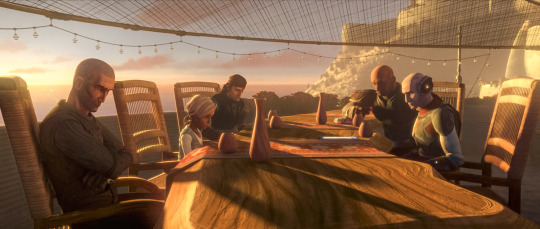
Barton IV is, as Crosshair states, a “remote, understaffed facility. It shouldn’t be a problem to infiltrate.” He can barely hold eye contact with Hunter while saying it, when once he was Hunter’s second. Hunter wants Omega to be safe and instructs her to remain behind, but she is adamant that they should stick together, just like she always has since joining them. Hunter almost looks like he’s going to cry, but he relents to both her demands and Crosshair’s input, although he is still suspicious of Crosshair’s motives.
Before they leave, Crosshair has his original Bad Batch armor returned to him by Wrecker. His old identity and loyalties, kept by his family the same way he never left their hearts. A contrast to his previous mission, where Crosshair and the other clones are considered “used equipment,” and their only purpose is to protect and retrieve the shiny new armor meant for their replacements.
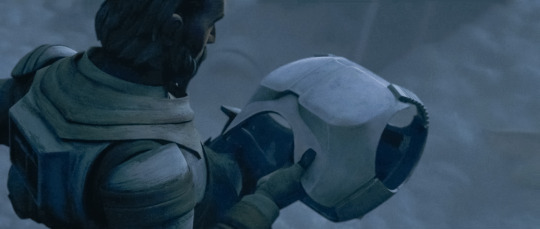
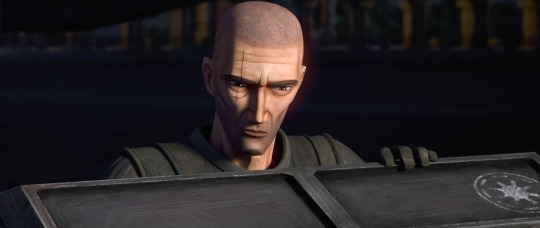
As they make their way to the base, the weather also points to a drastic difference between the two episodes. In The Outpost, the weather is MISERABLE. Cold, stormy, clouded, dangerous. Crosshair’s inner turmoil at that time cost Mayday his life, and broke his allegiance to the Empire. But on their return it is clear, sunny, calm, settled—almost serene (on the surface). Crosshair has thawed and grown as a person, and his emotions appear to be in a much calmer, if somber, place. As they land, Echo states that there are no signs of life on the scanners.
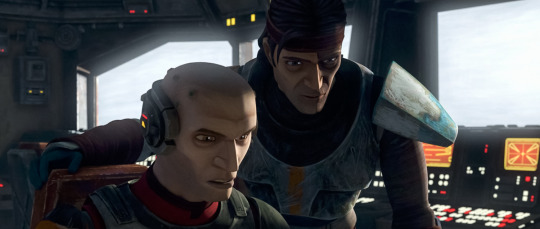
The planet is a graveyard. A memorial. A resting place. Made to dredge up and bury.
A baptism. A resurrection.
They exit the ship, and a vulture shrieks overhead, a reminder of Crosshair’s failures. Crosshair lifts his head to look at it, and his shoulders slump. (There’s an excellent little explanation of the vulture symbolism here.)
Mayday had told him that the vultures are vicious creatures who find a way to survive. They bury the dead and they take the scraps and they clean up for everyone else. They are shunned but beautiful. And they survive. Against all odds.
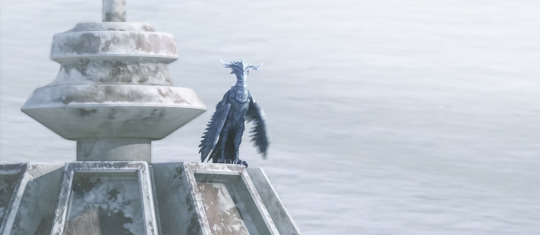
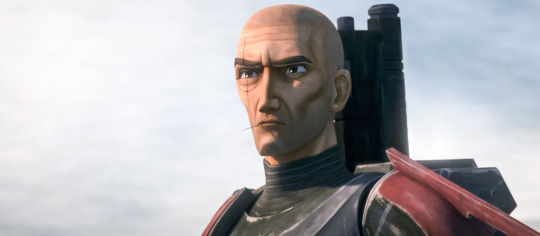
The second the vulture disappears, tension between Hunter and Crosshair begins to spill over. While the others are happy to see Crosshair assuming his old identity, Hunter is suspicious that the planet is deserted yet still heavily guarded by sensor beacons, and rounds on Crosshair demanding explanations. Crosshair has willingly led them to the site of his trauma but he is NOT ready to talk about it yet, and matches Hunter snark for snark. According to him (he should know) the danger (local raiders) has been taken care of. Hunter is even more pissed off as he gets a glimpse of Crosshair’s activities under the Empire, and Omega is disappointed in both of them. Their feelings remain tense and tight as Echo convinces them all to get inside and focus on their mission.
Once inside, Wrecker asks a question that encapsulates the fate of all the clones.
“So why’d the empire abandon this place?” “I guess it served it’s purpose.” “Hmm, sounds familiar.”
This prompts Crosshair to separate from the rest and go to a side storage room, where he first comes across the same heater that Mayday had once carried over to him as a gesture of friendship. It is dark and dead now. A sweep of his flashlight, and an even more sickening sight awaits him. All of Mayday’s troopers helmets, once lined up in a silent memorial, are now in a pile on the floor. And Mayday’s is among them.
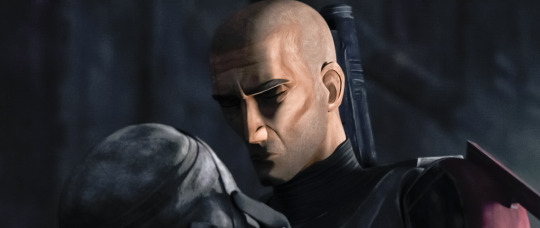
Crosshair must have known this was a possibility, coming back. He isn’t ready to talk about his feelings toward this place, but his face tells us all we need to know about his grief and his regret. He steps over and in reverence, greets the helmet of his friend. He understands now. Loss, grief, death. The burden that Mayday carried. Succumbed to. At the time, Crosshair had merely watched. Now he participates and gives Mayday and his squad the honor they are due. Hunter, who has become more and more suspicious of what Crosshair isn’t telling him, catches sight of his brother honoring a (supposedly) random group of regs, but slips away to not disturb him. Yet.
Crosshair rejoins the others as the sensors are turned off to redirect the power supply, and Batcher suddenly starts acting up. Crosshair takes her seriously, although he is forgetting something important that Mayday once told him—“you’ll freeze to death in that armor—if what’s in the ice doesn’t get you first.” Typically this is Hunter’s job, to be alert to shifts in the environment, but he is so focused on Crosshair “leaving” that he seems to be completely unaware of something stirring outside.
Crosshair walks out both to scout and to process his feelings, and is greeted with an up close look at the ice vulture that has haunted him. He starts to scowl and as the bird takes off, asks “are you going to be my shadow everywhere?” A statement that could hold true for both the vulture and Hunter, who has followed him. And Hunter gets right to the heart of it.

“I know you,” he says. Or I did, before you became someone I don’t recognize. Someone who would betray us and leave. “There’s more you’re not telling us. Start talking. What did you do to get on the Empire’s bad side?” Hunter needs proof. He wants to know how the brother who swore loyalty to the Empire thrice over and stayed on that Kaminoan platform had a supposed change of heart. But he frames it bitterly, believing that Crosshair is simply repeating a pattern—one that had almost made them enemies.
Crosshair’s hand shakes so much that his toothpick slips (like the sharp and pointed wit that often protects and comforts him), and we see a rumbling in the ice. Their emotions are starting to bubble and seethe.
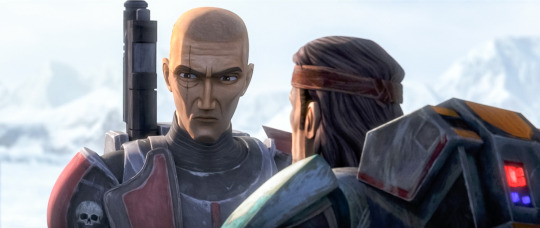

“You thought we’d take you back and not ask questions? I don’t think so.” Hunter is losing his grip on his emotions and physically shoves Crosshair in an attempt to spark the fight. His face is drawn, angry, and anticipating hurt.
Crosshair remains remarkably calm, not even necessarily wanting to make an argument out of it, but he eventually responds to Hunter’s indignation with his own. And this time he doesn’t hold back. He starts at the end, admitting he killed an Imperial officer, but holds the tender explanation of why close to his chest still. Instead he tells Hunter what he thinks he wants to hear—that his betrayal of the Empire mirrors his betrayal of the Batch. Except Crosshair adds his own perspective—that he only betrays after feeling like he has been betrayed first.
Hunter doesn’t have time to ponder that information as Crosshair now unleashes the root of his own turmoil onto him—and he knows how to hit Hunter where it hurts. Where he’s failed.
“I risked EVERYTHING to send you that message! You ignored it. You let Omega be taken to Tantiss.” The hurt blooms on Hunter’s face. “You failed.”
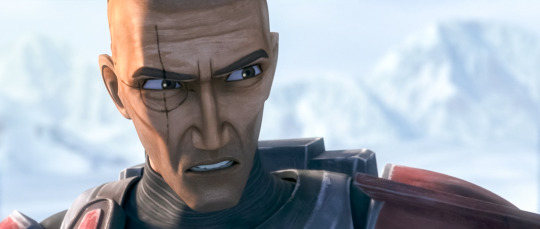
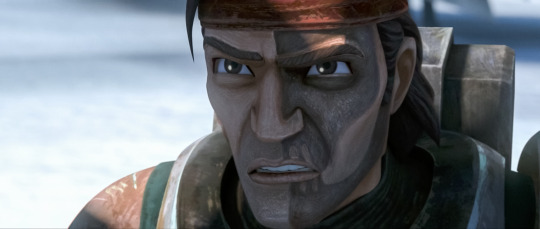
Crosshair isn’t even concerned about what happened to him on Tantiss. He’s concerned about Omega. And he knows that fact will twist Hunter’s gut in ways nothing else can. Hunter is their leader. He by default bears the blame of what happens to them, even though his squad makes their own choices freely. Crosshair doesn’t want to let him forget it. Hunter never lets himself forget it either.
Both men only know their own sides of the story. And it’s tearing them apart.
They’re ready to trade blows but their attention is pulled back to their family and larger circumstances by Batcher barking. Hunter finally realizes where their emotions have brought them, but it’s too late. The snow erupts from a giant wyrm creature, no longer kept at bay by the high-pitched hum of the sensors. No matter the gulf between him and Crosshair, Hunter’s first priority is to shove him away screaming “move!”--echoing Mayday trying to save Crosshair during the avalanche. They fall to their knees and the ground splits between them. They barely make it back to the base as the symbol of their outburst chases them across the snow.
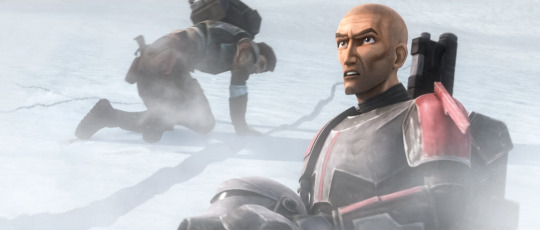

Plans are made. The squad won’t be safe until this threat is dealt with. Each member volunteers their strengths. Hunter is in mission mode now, his face open, and extends an olive branch after his brother offers to shoulder the burden of leading the creature back beyond the perimeter alone. “We’ll do it together.” But now it’s Crosshair’s turn to be suspicious. Will Hunter really trust me again? Can I trust him?
The creature follows them. Disaster strikes. Hunter shrieks and falls below the ice. All animosity gone, Crosshair rushes to him, panic lacing his voice. Hunter! I can’t lose you the way I lost Mayday, buried beneath the snow.
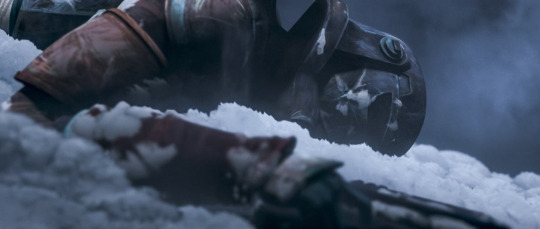
And now, it is Hunter’s turn to tunnel into the darkness below the ice and face everything he’s been running from. Shot for shot, Crosshair has already been on this journey, already faced himself, his fears, his failures, down there. They can’t reconcile their perspectives, because Hunter has yet to do the same. Hunter commits to making sure that the wyrm is led away from his family, putting himself in harms way to make sure they stay safe. However, he has a safety line—Crosshair and Batcher up top, tracking him, covering for his usual role.
“We found a weak point in the ice. We’ll try to dig through.” “You’ll try?” Their old banter makes a hesitant appearance. Hunter is still running. Crosshair is willing to try, as long as that effort is acknowledged. But despite their words, they hope that they won’t let each other down this time.
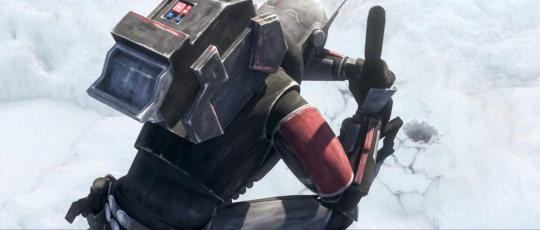

“Am I going to have a way out or not?” “If you end up where we hope you do.” Hunter needs reassurance of an outcome first. But Crosshair reminds him that he is the only one who can plot his path, and its consequences. Hunter has to take responsibility for his own journey. The way out of this predicament hinges on how far, and where, Hunter lands. And he won’t take shortcuts, even when Crosshair begs him to go ahead and exit the tunnel once they find each other. He begged Wrecker to get Tech back onto the railcar. This time, he’s in the trenches himself.

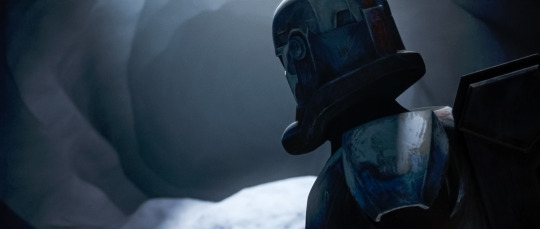
Tuned into his senses again, Hunter still doesn’t jump even as he feels the wyrm get closer, until the sensors are reactivated. Finally, he accepts Crosshair’s to help pull him out of the literal mouth of danger as the worm barrels into view. And they run again, leaping to safety just in time, having accomplished their mission. The wyrm is now harmless, roaring at them from the other side of the perimeter, chastened until it finally slinks away.
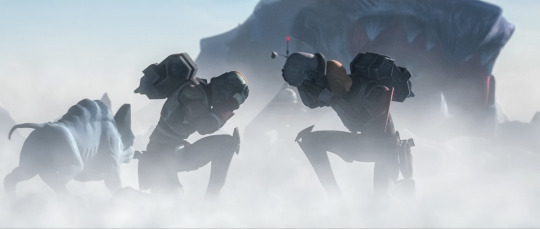
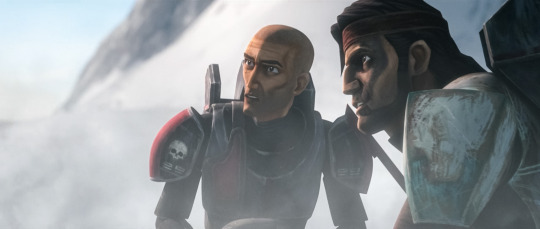
The boys collapse, share a fully open look. All they need now is a nod. They have each others’ backs. Approval, gratitude, and trust now have space to grow. They are brothers again.
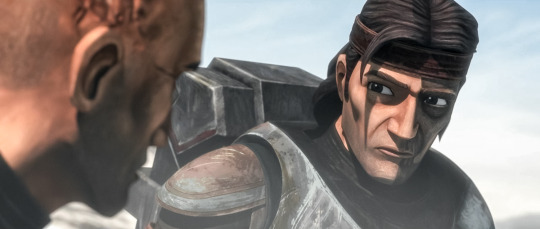
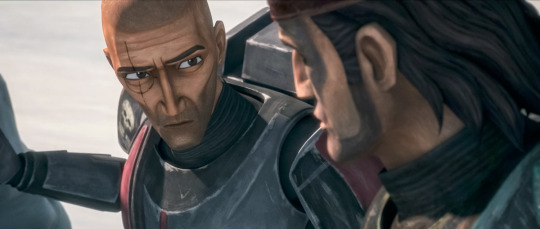
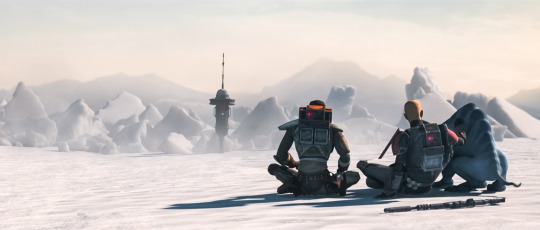
And Crosshair gets a redo of his trek back to the platform, except this time, instead of Mayday dying in his arms, Hunter is by his side, unharmed, and Batcher prances alongside them. Instead of silent TK Troopers and the insolent sneer of Lieutenant Nolan, they are greeted by Echo and Omega’s shining faces, and Wrecker running to meet them (and hug them. We all know they secretly loved it.)
(Side note: both Crosshair and Hunter have shown self-sacrifice on behalf of someone else in these parallels. Behind the scenes, Echo and Omega have a conversation that hints at the fact that Omega might be contemplating the same. The outcome of the guilt and confusion shadowing her even while Crosshair returns to the light remains to be seen, but it does not bode well.)
The episode could end here. But it doesn’t. Now the real conversations can begin. It’s late in the evening and they have dug their ship out in order to depart. Bathed in warm light, Crosshair is finally ready to open up, at least a little, although he can’t face Hunter in the process.
“I thought I knew what I was getting into with the Empire.” Owning up to his perspectives, not shifting blame. It was a choice he made. “I’ve done things. I’ve made mistakes.” Ones that he regrets. Crosshair's default is still to paint himself in the worst light possible when trying to reconcile with someone, in the hopes that the darkest parts of him will be accepted. He so desperately wants to be accepted for who he is, even when he knows he has done terrible things, and maybe especially, because he hasn't fully forgiven himself for them yet. So he tries to shock and hurt in the hopes that either his inner self-loathing will be corroborated, or his need for forgiveness can come from an outside source.

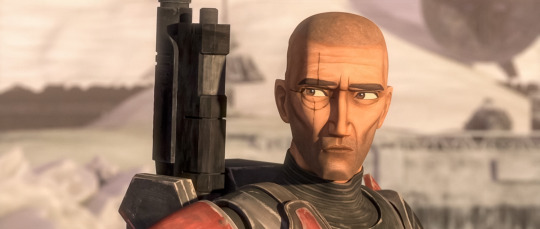
And Hunter does forgive him, and doesn't even dwell on the many, many things he could blame Crosshair for, now that his own anger has passed. He acknowledges that he has regrets too, gives an even playing field by saying that none of them really had full information of what was going on when their separation first began, and extends solidarity in the best way he knows how.
A smoothing of the path behind, and a glimpse toward the path ahead. He doesn't know what it holds either, but he's willing to walk it together.
And I think their choice of words is what they needed from each other. Hunter needed to know how Crosshair viewed his own actions. Crosshair needed to know how Hunter felt about the consequences, both those caused by him and those caused by Hunter’s own choices since. Hunter has always questioned his brother’s perspectives—his mind. Crosshair has always questioned his brother’s heart—his loyalty. Their strengths--and also their weaknesses.
“All we can do is keep trying to be better. Who knows? There might just be hope for us yet.”
And for now, it’s enough. Crosshair looks into the sky, watches the ice vulture flying overhead once again, except this time, it flies off into the sunset, leaving him still mournful, but slightly more whole than when he first arrived.
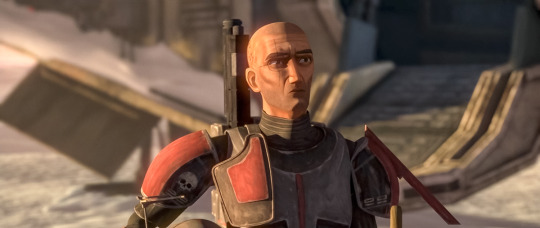

✨ Tag List ✨
@drafthorsemath @freesia-writes @sunshinesdaydream @the-bad-batch-baroness @heyclickadee @the-little-moment @ladyzirkonia @jedizhi @burningfieldof-clover
#the bad batch#tbb#star wars#crosshair#crosshair bad batch#tbb crosshair#tbb spoilers#the bad batch spoilers#hunter#hunter bad batch#tbb hunter#the return#the outpost#tbb meta#the bad batch meta#long post#some light ramblings#somelightramblings#some light edits#somelightedits
166 notes
·
View notes
Text
Subway Bosses + Detective!Reader - Spooky Month Part 1
“Sorry, guys; I won’t be able to make it to Elesa’s party. I’m on patrol duty.”
For a split second, the pair of smiling faces in front of you falter in enthusiasm before twisting into something more closely resembling skepticism.
“You’re still required to go on patrols as a detective? I would’ve thought the department would assign… well, patrol officers.”
You smile and shrug. It’s a fair question. “It’s Halloween night in the city. Lots of parties with lots of people.”
“Can someone else cover for you?”
“I wouldn’t count on it; the department’s already stretched thin.”
Not to mention you had already agreed to the night shift weeks ago; if you had known a supermodel was going to invite you to a costume party, you would’ve declined the job. Or at least chosen an earlier shift. As is, you’ll be hard-pressed to find anyone willing to walk around the city in the middle of the Autumn night, just so you can have fun.
Across the table, Ingo does his best to mask his disappointment with a contemplative hum before glancing down at his drink. Meanwhile, Emmet sinks a little deeper into his chair, a small pout replacing his usual smile. Despite the twinge of guilt that comes from seeing your friends so disappointed, you can’t help but laugh at their behavior. Halloween really is for all ages.
“I’m sure you guy’ll have plenty of fun without me. Besides, we’ve still got the rest of the month. Let’s enjoy it while we can, deal?”
Emmet visibly perks up at your offer, struggling to keep the frown on his face before he chuckles.
“Deal.”
One evening, Emmet came to you for help with trying on some face paint for his costume. Apparently he had tried it himself previously, but the end result looked less like blood and more like he’d tried eating a cherry pie without the use of his hands; you would have to ask Ingo if anyone in the station took a picture. And while you’re no make-up expert, you certainly know your way around blood and wounds. Suffice it to say, Ingo got a good fright from seeing his brother with fake blood running down his face.
You may or may not have done some pumpkin carving over the weekend. A matching pair of pumpkins, the same size, shape, and color. Each had a set of eyes, a nose, and a mouth, though one was sporting a rather festive smile, while the other had a spooky frown.
The Gear Station is decorated with all sorts of lights and colors, and some of the depot agents have begun wearing make-up and little accessories to celebrate the creepy season. This has inadvertently lead to several kids commenting on your “detective costume”. You don’t really mind the kids that think you’re dressing up, though something doesn’t sit right with you whenever someone says your costume doesn’t look “cool enough”. Perhaps you should ask Elesa for some fashion advice the next time you see her.
You were working at the station one day when Ingo all but shoved a half-empty bag of candy in your hands and, with a deathly glare, instructed you to hide the bag and guard it with your life. Five minutes later, Emmet approached you and asked if his brother passed by recently. You made an offhand remark about him wanting to inspect some of the cars, and that was all Emmet needed to hear before he ran off. You quickly got on the next train, deciding to ride the lines for an hour. Maybe two, just to be safe.
So. Many. Movies. Many an afternoon and evening have been spent discussing horror movies and debating over which is the best one, suffice it to say, you’ve yet to see conclusion in the near future. How anyone can stomach over the top gore and gratuitous content is beyond Ingo’s comprehension, and, according to Emmet, the time spent sitting through a slow-building thriller is rarely worth the payoff.
As per yearly tradition, the amusement parks have been given a Halloween makeover. The usual technicolor rainbow of the coaster tracks has been swapped out for dark purples and sickly greens, with cutouts and masked actors popping out as your cart travels along the rail. The scares are a lot less effective when you’ve got someone on either side of you, joking about how they’ll keep you safe. The ferris wheel has been left mostly unchanged, but the view from above during the night lets you truly take in all of the decorations and costumes as people travel around.
Although you might not be able to spend Halloween night with your dear friends, there’s still plenty of time to enjoy the season before the month’s up.
9 notes
·
View notes
Text
To be True
we need to guard what we have come to “believe...”
Paul instructs Timothy (and all of us) in this in the writing of his Letter with Today’s chapter from First Timothy:
But even so, the Spirit very clearly tells us that in the last times some will abandon the true faith because of their devotion to spirits sent to deceive and sabotage, and mistakenly they will end up following the doctrine of demons. They will be carried away through the hypocrisy of liars whose consciences have been branded with a red-hot iron, saying, “Don’t marry. Don’t eat such-and-such foods.” But God created all these to be received with gratitude by people who hold fast to the faith and really comprehend the truth. For everything God made is good. That means nothing should be rejected as long as it’s received with a grateful heart, for by God’s word and prayer, it is made holy.
Place these truths before the brothers and sisters. If you do, you will be a good servant of Jesus the Anointed, raised and fed on words of true belief, trained in the good instruction you have so clearly followed. Reject worldly fables. Refuse old wives’ tales. Instead, train yourself toward godliness. Although training your body has certain payoffs, godliness benefits all things—holding promise for life here and now and promise for the life that is coming. This statement is worthy of trust and our full acceptance. This is what we work so hard for! This is why we are constantly struggling: because we have an assured hope fixed upon a living God who is the Savior of all humankind—especially all of us who believe.
So go out and insist on these things. Teach them. Don’t let anyone belittle you because you are young. Instead, show the faithful, young and old, an example of how to live: set the standard for how to talk, act, love, and be faithful and pure. Until I get there, make sure to devote yourself to the public reading of Scripture, to exhortation, and to teaching. Don’t neglect the gift that was given to you through the prophecy spoken when the company of the elders laid their hands on you. Cultivate all these practices; live by them so that all will see how you are advancing and growing. Take care of yourself, concentrate on your teaching, and stick with these things. If you do, then you will be effective in bringing salvation to yourself and all who hear you.
The Letter of 1st Timothy, Chapter 4 (The Passion Translation)
Today’s paired chapter of the Testaments is chapter 21 of 2nd Kings that documents the life & times of various kings that includes astrology, black magic, séances and fortunetelling, all things that God our Creator has instructed us not to be involved with:
[Manasseh of Judah]
Manasseh was twelve years old when he became king. He ruled for fifty-five years in Jerusalem. His mother’s name was Hephzibah. In God’s judgment he was a bad king—an evil king. He reintroduced all the moral rot and spiritual corruption that had been scoured from the country when God dispossessed the pagan nations in favor of the children of Israel. He rebuilt all the sex-and-religion shrines that his father Hezekiah had torn down, and he built altars and phallic images for the sex god Baal and sex goddess Asherah, exactly what Ahaz king of Israel had done. He worshiped the cosmic powers, taking orders from the constellations. He even built these pagan altars in The Temple of God, the very Jerusalem Temple dedicated exclusively by God’s decree (“in Jerusalem I place my Name”) to God’s Name. And he built shrines to the cosmic powers and placed them in both courtyards of The Temple of God. He burned his own son in a sacrificial offering. He practiced black magic and fortunetelling. He held séances and consulted spirits from the underworld. Much evil—in God’s judgment, a career in evil. And God was angry.
As a last straw he placed the carved image of the sex goddess Asherah in The Temple of God, a flagrant and provocative violation of God’s well-known statement to both David and Solomon, “In this Temple and in this city Jerusalem, my choice out of all the tribes of Israel, I place my Name—exclusively and forever. Never again will I let my people Israel wander off from this land I gave to their ancestors. But here’s the condition: They must keep everything I’ve commanded in the instructions my servant Moses passed on to them.”
But the people didn’t listen. Manasseh led them off the beaten path into practices of evil even exceeding the evil of the pagan nations that God had earlier destroyed.
God, thoroughly fed up, sent word through his servants the prophets: “Because Manasseh king of Judah has committed these outrageous sins, eclipsing the sin-performance of the Amorites before him, setting new records in evil, using foul idols to debase Judah into a nation of sinners, this is my judgment, God’s verdict: I, the God of Israel, will visit catastrophe on Jerusalem and Judah, a doom so terrible that when people hear of it they’ll shake their heads in disbelief, saying, ‘I can’t believe it!’
“I’ll visit the fate of Samaria on Jerusalem, a rerun of Ahab’s doom. I’ll wipe out Jerusalem as you would wipe out a dish, wiping it out and turning it over to dry. I’ll get rid of what’s left of my inheritance, dumping them on their enemies. If their enemies can salvage anything from them, they’re welcome to it. They’ve been nothing but trouble to me from the day their ancestors left Egypt until now. They pushed me to my limit; I won’t put up with their evil any longer.”
The final word on Manasseh was that he was an indiscriminate murderer. He drenched Jerusalem with the innocent blood of his victims. That’s on top of all the sins in which he involved his people. As far as God was concerned, he’d turned them into a nation of sinners.
The rest of the life and times of Manasseh, everything he did and his sorry record of sin, is written in The Chronicles of the Kings of Judah. Manasseh died and joined his ancestors. He was buried in the palace garden, the Garden of Uzza. His son Amon became the next king.
[Amon of Judah]
Amon was twenty-two years old when he became king. He was king for two years in Jerusalem. His mother’s name was Meshullemeth, the daughter of Haruz. She was from Jotbah. In God’s opinion he lived an evil life, just like his father Manasseh. He followed in the footsteps of his father, serving and worshiping the same foul gods his father had served. He totally deserted the God of his ancestors; he did not live God’s way.
Amon’s servants revolted and assassinated him, killing the king right in his own palace. But the people, in their turn, killed the conspirators against King Amon and then crowned Josiah, Amon’s son, as king.
The rest of the life and times of Amon is written in The Chronicles of the Kings of Judah. They buried Amon in his burial plot in the Garden of Uzza. His son Josiah became the next king.
The Book of 2nd Kings, Chapter 21 (The Message)
my personal reading of the Scriptures for Saturday, december 26 of 2020 with a paired chapter from each Testament of the Bible, along with Today’s Psalms and Proverbs
A post by John Parsons about the True nature of our hope:
“The LORD will perfect that which concerns me: Your love, O LORD, endures for ever: do not forsake the works of your hands” (Psalm 138:8). Here is the confession that all that we are or ever hope to be comes entirely from God, and therefore we can take heart. The LORD will finish the work he has begun in you: “Fear thou not, for I AM with you; be not dismayed, for I AM thy God; I will help you; yea, I will strengthen you, yea, I will uphold you with the right hand of my righteousness” (Isa. 40:10). Understand that the LORD’s purposes are sure and his promises will invincibly be fulfilled, “for his lovingkindness is infinite” (כִּי לְעוֹלָם חַסְדּו). God will never forsake you nor abandon the work of his hands, but will providentially preserve his handiwork and consummate his vision of love (John 17:22; Eph. 1:10). Amen, “He who began a good work in you will bring it to completion for the Day of Yeshua the Messiah” (יוֹם יֵשׁוּעַ הַמָּשִׁיחַ, Phil. 1:6). “Now to him who is able to keep you from stumbling and to present you blameless before the presence of his glory with great joy, to the only wise God our Savior (μόνῳ σοφῷ θεῷ σωτῆρι ἡμῶν), be glory, majesty, dominion, and authority, before all time and now and forever. Amen” (Jude 1:24-25).
The Torah of Joseph proclaims: “God sent me before you to preserve you...” (Gen. 45:7). The mercy of God goes ahead of you to prepare a place for you (John 14:2). We may not know the details of our journey, but the “how” and the “way” is promised to us, as is our ultimate destination – the heavenly place of God, the Presence of our Beloved...
Happy holidays and love to you, friends. [Hebrew for Christians]

https://hebrew4christians.com/
12.24.20 ��� Facebook
Today’s message from the Institute for Creation Research
December 26, 2020
The Trinity in Ephesians
“There is one body, and one Spirit, even as ye are called in one hope of your calling; One Lord, one faith, one baptism, One God and Father of all, who is above all, and through all, and in you all.” (Ephesians 4:4-6)
Paul’s letter to the church at Ephesus is surely one of the most profoundly doctrinal—yet intensely practical—books of the Bible, and it is not surprising that the doctrine of the triune God breaks into his message so frequently. For example, note Ephesians 2:18: “For through [Christ] we both have access by one Spirit unto the Father.”
More often, however, it appears not in a succinct formula like this but rather in interconnected references to the Father, the Son, and the Holy Spirit, always implying that each is deity, but never that they are three different “gods.” Paul prayed that “the God of our Lord Jesus Christ, the Father of glory, may give unto you the spirit of wisdom and revelation in the knowledge of him” (Ephesians 1:17).
He also prayed “unto the Father of our Lord Jesus Christ,...That he would grant you,...to be strengthened with might by his Spirit in the inner man; That Christ may dwell in your hearts by faith” (Ephesians 3:14, 16-17). Thus, the believer is “filled with all the fulness of God” (v. 19).
We are exhorted to “grieve not the holy Spirit of God,...even as God for Christ’s sake hath forgiven you” (Ephesians 4:30, 32). And “be filled with the Spirit;...Giving thanks always for all things unto God and the Father in the name of our Lord Jesus Christ” (Ephesians 5:18, 20).
There are others, but note especially our text, speaking of our unity in Him and His triunity in us. “There is...one Spirit...One Lord,...One God and Father of all, who is above all [i.e., the Father], and through all [the Son], and in you all [the Spirit].” All this is a magnificent mystery, but a wonderful reality! HMM
0 notes
Text
Naruto D20 Episode 1.25: AKA Dow Finally Does A Good
So at the end of session 1.2, I let the characters go off and “train,” which basically consists of the players selecting a jutsu that their characters have literally never even heard of, and rolling a die to see if they can “learn” the jutsu with no instruction or prior knowledge of the jutsu’s existence.
^^literally my reaction after realizing how dumb it is that that’s the process for learning techniques.
Like, I let it slide in session 1.1 because the players selected techniques that the characters could feasibly have heard of, and could practice on their own, but then my players selected some highly specialized techniques for session 1.2′s training time and it just felt…wrong? I guess? And it’s wrong for a few reasons:
One, there is no way that you can learn how to do something if you don’t know that something exists and you have no one showing you how the something is done. Like, that goes for everything. Allowing players’ meta-knowledge to affect gameplay is like DM cardinal sin number 4. Player knowledge and character knowledge should always be kept separate. No exceptions.
Two, you lose out on so much roleplaying ability. Like, the source anime and manga’s training sequences were arguably better than some of the fight scenes at times. Naruto spends like over half his time training, and the immense payoff that you get from watching him finally succeed only comes from watching the episodes of him struggling and working to get a new skill or technique to work. And the payoff was usually awesome.
So I decided to fix breaking DM cardinal sin number 4, by breaking cardinal sin number 3: I retconned the last third of session 1.2
^^Basically how I started this session.
Let me preface what happened next by saying that yesterday, I literally lost my job and became homeless so I did not have anything planned. I was fully expecting this to crash and burn. But it honestly turned out to be the best session we’ve had yet, and I would even go so far as to say I enjoyed DMing this session more than playing some of the sessions I’ve played. I know the two experiences cannot necessarily be compared 100%, but today’s mini-session was honestly so fun and very refreshing, and the two players I had with me today (the third is currently MIA and I just hope that he is doing ok) agreed.
Basically, my stipulation for learning techniques became that you had to roll high enough on a knowledge check for ninja lore to see if your character knows of the technique. In addition, you had to have someone who knew the technique teaching it to you, or you had to have had enough experience watching the technique being performed to try and learn it on your own, but the second way would come with a penalty to the learn check. Finally, instead of just rolling and you either got it or you didn’t, you had to put in the work to learn how to do the thing. In other words, you actually had to train your character. Roleplay over rollplay.
I’m gonna need to copyright that phrase.

And I mean, at the end of the day, the roll to learn the technique is ultimately what dictates whether or not the technique gets learned. But, regardless of the roll’s outcome, the character would literally be expending eight hours of their time trying to learn this new skill, and while I could just jump ahead eight hours, the chance for character development and interactions during that period would be completely lost.
Zaki, played by B (who has given me permission to tag him @baumguy), decided that he would spend his time training by going to his grandmother’s dojo to work on his swordfighting. His grandmother, Kisagana, who is the daughter of the Akatsuki member Kisame, has long since left her mentoring days behind her, but she does have Mutsumi, a young Chuunin who is working to take over for her when she does decide to step down as sensei of the dojo. @baumguy rolled well enough on a knowledge check that his character had heard of the technique he wanted his character to learn enough to ask about it by name, and Mutsumi had the necessary knowledge to train him to perform that technique, which meant that all the prerequisites I had set for learning a technique were met, and the roleplay began.
@baumguy kicked it off with a successful learn check, so from there it was just a matter of some good old fashioned sparring. Now, I hadn’t prepared any of what was going to happen, really. I just gave her one or two basic character traits. She began by demonstrating the technique, and then had him attempt to recreate what she showed him. He would practice for a bit, Taijutsu rolls indicating how well each attempt went, and when Zaki needed some pointers (rolled poorly on an attempt to perform an aspect of the technique enough times in a row), she stepped in and offered them.
It wasn’t by any means a necessary interaction. Poor rolls didn’t have permanent consequences, because he had already rolled well enough to perform the technique, but it gave a process that would normally just consist of a simple learning check much more life, and allowed Zaki and Mutsumi to grow as characters, playing off of each other and allowing different aspects of each of their characterizations to shine through.
By the end of it, Zaki had pretty well mastered the technique, but just to keep him from getting too inflated of an ego, Mutsumi let him know that he still had lots of room for growth and improvement:
Meanwhile, Tamotsu and Rin (played by J from the RWBY campaign in which I play Iris) shared a moment at Ichiraku Ramen, learning a bit about each other’s histories and Tamotsu was able to get a better idea of where Rin was looking to improve. The thing about Rin is, she has a bloodline that canonically in her backstory is difficult to control, but she knew no Chakra Control techniques at all. This simple fact not only made Tamotsu, a descendant from a clan also famous for an incredibly difficult to control bloodline (so difficult that only Tamotsu himself had mastered it, and even that required the chakra of Yamato, the last surviving host of Hashirama’s cells, to be introduced into Tamotsu when his bloodline activated years before), the ideal teacher for Rin to study under, but it also meant that he had to start with the bare basics of Chakra Control for Rin:
Tree Climbing Technique!
This training came quite naturally to Rin, so her training consisted of a simple explanation followed by a demonstration, after which she was free to practice as she pleased. Tamotsu had something to take care of, and left her to her training, promising to return in the evening to see her progress, which he did and found her sitting at the top of the tree, having mastered the technique, adding it to her repertoire.
For Rin, the roleplaying was more about establishing rapport between herself and the person she will likely spend a lot of time training under directly, not to mention go on missions for. So yes, there was a different learning style involved, but that also comes with the nature of the technique itself. Some techniques can be learned without extensive hands-on training, while others are learned best with someone to oversee the entire learning process.
I’m not going to pretend that I’ve in any way perfected the style of this campaign. I know I still have lots to work on, and I know that we’ve really only just begun. But I feel for the first time like I have a shot at creating a story and an experience for my players that is not only enjoyable and fun, but also deep, rich, and at times surprising. I know I surprised myself with how well this session went.
And while I know I still have to find out what our favorite squid boy Maindo (played by M, also from the RWBY campaign) got up to while Zaki and Rin were training, I’m much more confident moving forward in my storytelling ability and just general comfort level with not having every little detail fleshed out before a session. And even with these minor interactions that seem meaningless in the grand scheme of things, I feel like I’m still able to move the overarching plot forward. I’ve got some big things planned for my tiny ninja friends. I just can’t wait for them to see what’s in store.

So, I know I forgot my takeaways from 1.2, but as far as 1.25 goes, I’d just say I learned to relax. DMing does not have to involve nearly as much planning or stress as I was initially putting into it. While major characters do need to be developed fully for combat situations and such, minor interactions don’t necessarily require a lot of prior planning, and it’s quite possible that planning more might have made the interactions feel less genuine or fulfilling.
I’m still learning this whole thing. And probably will be the entire campaign. But hey, I know for a fact that both my players and I had fun this session, and in my book, that’s 99% of what matters.
Now thanks to the whole real life thing (you know, the unemployment and homelessness bit), I am very exhausted after driving so long with so little sleep, so my bed now calls. But I always feel the need to gather my thoughts on sessions before I go to bed, just so I can make sure I remember all the things I want to document. That now complete, I await the sweet gift of the Sandman until tomorrow morning (or afternoon, who knows, I’m exhausted)
(Can you tell I’m excited for Christmas?)
0 notes
Text
What Leonardo da Vinci Couldn’t Finish
The 500th anniversary of the death of Leonardo da Vinci will bring big doings to Paris this fall with the largest-ever and one-stop-only career survey at the Louvre. And New York gets a shot of buzz in advance with the opening at the Met on July 15 of a single-painting show of one of the most rawly emotional images in the Leonardo canon.
Leonardo was a star from the start. According to the 16th-century art historian Giorgio Vasari, his contemporaries found him terrifically attractive. (Vasari calls him “divine” a dozen times in a 20-page Leonardo biography.) Genial, gorgeous, brainy and a fashion plate (partial to pink), he had the poise of a prince and a philosopher’s ruminative mind. In his long career as artist, architect, scientist and inventor, grace and talent combined to smooth his path from rural Tuscany, where he was born in 1452, to the courts of Milan and papal Rome, to France where, as pet artist to Francis I, he died in 1519.
But that ruminative cast of mind caused problems. Basically, before Leonardo did anything he had to know everything: how his paints and varnishes were made, how the human body was internally structured, and what creating art might mean in the cosmic scheme of things.
This entailed, Vasari notes, research, experimenting, lots of conversation, and long stretches of silent thinking, and rethinking. In the biography, he has Leonardo himself explain, for the benefit of an importunate patron, that “when the greatest geniuses are working less they actually accomplish more.” The net effect was that relatively little painting got done, and a lot of what got started was never finished.
The painting at the Met, “Saint Jerome Praying in the Wilderness,” on loan from the Vatican Museums, is one of those unfinished pictures. It was likely begun around 1483, and you see instantly that it’s a work in progress: fined-tuned here, slapped down there. Incompleteness is part of its power. And powerful this picture is, as dramatically rich as a three-act opera, with a full-throttle aria of scorching anguish at its center.
Equally important, its “non finito” state is formally instructive. It lets us see Leonardo’s distracted, stop-and-start painting method in action.
The picture is one of a dozen or so works widely accepted as being, without question, from his hand. It depicts an early Christian saint who, after a self-punishing stint as a desert ascetic, settled for years in Rome where he turned his attention to translating the Bible from Hebrew and Greek into Latin. Many Renaissance paintings of Jerome (347-420 A.D.) show him immersed in this scholarly labor, usually accompanied by a snoozing lion, a kind of emotional support companion. The mood of such pictures tends to have a cozy Peaceable Kingdom vibe.
Leonardo’s painting does not. Here saint and beast alike are untamed. This is the Jerome of desert wildness, or maybe the one who ended up dying far from Rome in a rock-hewn cave near Bethlehem. Aged, nearly toothless, and sun-scorched, he holds a stone in his extended right hand, as if about to deliver a penitential blow to his chest. At his feet is the lion, sleek, alert, tail curled like a scimitar, mouth opened wide in a growl.
We know nothing about why, or for whom, the picture was made. Carmen C. Bambach, the Met curator who organized the exhibition, proposes that it was started soon after the artist relocated from Florence to Milan. Although it reflects Leonardo’s Florentine style — and there’s a tiny sketch of what could be a Tuscan church in the upper right corner — it’s painted on a panel of walnut, a wood commonly used as a support in Milan, but very rarely in Florence.
Conservators have found evidence that Leonardo left off work at an early point and picked it up again, possibly more than once, later. Standing in front of the picture, which hangs, spotlighted, in a darkened gallery in the Met’s Lehman wing, you can get a sense of restless layers of activity.
In some areas it never progressed beyond a preliminary stage. The lion, a tawny silhouette with washy internal detailing, is a compositional place marker. The same is true of Jerome’s unmodeled rock-holding arm. But beginning just below the shoulder, this changes. Flesh suddenly gains shading; musculature develops. This naturalism spreads to the face, a construction of sinew and bone that brings Leonardo’s autopsy drawings to mind.
Even within this clinical precision, though, certain features are hard to read. At a glance, the saint’s eyes seem to be sightless or downcast. In fact, they are directed upward to a fleetly sketched, apparitional image of a crucifix seen in profile.
And, enchantingly, just behind the saint, a misted landscape appears, bringing the refreshment of color — sky-blue, tree-green — to a penumbral scene. In the exacting depiction of Jerome’s face and torso we see the hand and eye of Leonardo the anatomist. In the landscape, we see the naturalist, the botanist, the weather-watcher, the world lover. It may say something about this love that we find traces of the artist’s fingerprints in the landscape passage where he dabbed and smooshed paint by hand to create a soft-focus atmosphere.
Still, the painting’s real focus is Jerome’s agonized face. And its real subject, to my eye, is inflamed spiritual grief.
What we know is that Leonardo kept the picture with him till he died, then another history took over. The work drops from the record until the late 18th or early 19th century when the Swiss painter Angelica Kaufmann (1741-1839), then living in Rome, acquired it. At some point, pieces were cut from the panel — probably with the idea of selling the more finished sections — and later reassembled. At the Met, thanks to raked lighting, you can see repair lines around the saint’s head.
Why Leonardo left this and other pictures unfinished, we can’t know. Ms. Bambach, who organized the Met’s 2003 Leonardo drawing survey and whose awesomely ambitious four-volume study of the artist called “Leonardo da Vinci Rediscovered,” will appear later this month, suggests that the answer may lie in his relentlessly inquisitive personality: in a now-familiar internet way, every search for information he made turned up links to other searches, which he couldn’t resist pursuing.
And in this she’s in agreement with the forgiving Vasari, who wrote: “Leonardo’s profound and discerning mind was so ambitious that this was itself an impediment; and the reason he failed was because he endeavored to add excellence and perfection to perfection. As our Petrarch has said, the desire outran the performance.”
The result, both historians seem to suggest, is an art that, consciously or otherwise, privileges process over finish, experimentation over resolution: never having to say “done” was Leonardo’s comfort-zone mode. And in the case of the Vatican painting, this has a fantastic payoff: It leaves an expression of fever-pitch emotion ever burning. It will burn all summer, this furnace of anguished devotion. The Met better keep its air-conditioning on high.
Leonardo da Vinci’s Saint Jerome
July 15 through Oct. 6 at the Metropolitan Museum of Art, 1000 Fifth Avenue, Manhattan; 212-535-7710, metmuseum.org.
Sahred From Source link Travel
from WordPress http://bit.ly/2YZcU4Q via IFTTT
0 notes
Text
The benefits of active learning
In an article lamenting the reduction in kindergarten of teacher autonomy and child-directed activities, Washington Post columnist Valerie Strauss quoted early childhood development expert Nancy Carlsson-Paige:
We have decades of research in child development and neuroscience that tell us that young children learn actively – they have to move, use their senses, get their hands on things, interact with other kids and teachers, create, invent. But in this twisted time, young children starting public pre-K at the age of 4 are expected to learn through “rigorous instruction.”
Strauss noted in her article that researcher R. Clarke Fowler found that
about half the teachers who responded said their [Massachusetts] districts had adopted scripted programs in math and writing – and 60 percent in phonics and spelling – which reduce a teacher’s autonomy in instruction. Seventy-four percent of teachers from high-SES districts and 64 percent from low-SES districts reported their schools had cut the amount of time scheduled for child-directed activities in recent years.
Given what we know about teacher retention and/or the cognitive development of young children, this is incredibly dismaying (and not limited to Massachusetts). It also seems to be a harsh indictment of school leaders’ inability to enact research-based (or even common sense) best practices.
Of course the benefits of active learning are apparent beyond the kindergarten sector. For instance, the Hewlett Foundation and the American Institutes for Research have been studying ‘deeper learning schools’ in project- and inquiry-based learning networks such as High Tech High, the New Tech Network, Big Picture Learning, and the EL Schools. That research indicates that students in these schools generally have higher scores on both traditional state tests and international assessments. They also tend to report greater collaboration skills, greater feelings of belongingness, higher levels of academic engagement, greater motivation to learn, and higher levels of self-efficacy. They also are more likely to graduate high school on time, are more likely to enroll in 4-year colleges and universities (particularly true for 9th grade low achievers), and persist and graduate from college at higher rates. In other words, compared to more traditional schools, these schools ROCK IT on many of the outcomes that we say that we are trying to achieve for our students. Plus there’s a ton of research confirming the power of project-based learning, inquiry-based learning, student agency, and so on.
Unsurprisingly, these findings hold true at the university level as well. For example, when MIT changed its freshman physics class from a model of hundreds of students listening passively to lectures in an auditorium to a model of smaller, interactive classes that emphasized hands-on, collaborative learning, it found that attendance increased and that the failure rate dropped more than 50 percent. Research has shown that “most students learn fundamental concepts more successfully, and are better able to apply them, through interactive, collaborative, student-centered learning.” Similarly, the 10 or so universities participating in the Student Engagement in Mathematics through an Institutional Network for Active Learning (SEMINAL) project have begun to initiate active learning methods and collaborative problem-solving into their math courses. They are seeing increases in average test scores, decreases in students earning less than a C, and numerous other benefits. These postsecondary examples confirm research by the National Academy of Sciences that students in active learning environments are “33 percent less likely to fail in undergraduate science, technology, engineering, and math (STEM) courses.”
It’s pretty clear that active learning techniques seem to have multiple payoffs compared to more traditional instructional methods. The question isn’t whether active learning techniques work. The question is why we’re not doing more of them given the rich research supporting their effectiveness.
Image credit: 2011 Science Summer Camp 138, thewomensmuseum
Related Posts
We should be connecting students with real audiences
The future of learning [VIDEO]
Van Meter High and North High: Two Iowa schools that are rockin’ it
When parents want to opt their children out of ed tech
Project-based learning: We can do better than sugar cube pyramids
The benefits of active learning published first on https://buyessayscheapservice.tumblr.com/
0 notes
Text
Quantum Computers Strive to Break Out of the Lab
Tech giants and startups alike want to bring quantum computing into the mainstream, but success is uncertain
Photo: Christopher Payne/Esto
aside.inlay.rt.med h4 { color: #03a6e3; text-transform: uppercase; font-size: 16px; line-height: 20px; margin-bottom: 0; padding-bottom: 0; }
Photo: Christopher Payne/Esto
Futuristic Computer: Google’s new quantum computers look like props from a sci-fi film. Whether these complex devices will prove truly useful remains to be seen.
Schrödinger’s cat you’ve met—the one that is both alive and dead at the same time. Now say hello to Schrödinger’s scientists, researchers who are in an eerie state of being simultaneously delighted and appalled.
Schrödinger’s famous thought experiment has come to life in a new form because quantum researchers are at the cusp of a long-sought accomplishment: creating a quantum computer that can do something no traditional computer can match. They’ve spent years battling naysayers who insisted that a quantum computer was an unachievable sci-fi fantasy, and now these researchers are finally beginning to indulge in some well-deserved self-congratulation.
But they are simultaneously cringing at a torrent of press accounts that wildly overstate the progress they’ve made. Exhibit A: Time magazine’s quantum-computing feature of 17 February 2014, with the editors declaring on the cover that “the Infinity Machine” is so revolutionary that it “promises to solve some of humanity’s most complex problems.” And since then, many press accounts have been equally hyperbolic.
Graeme Smith, a quantum-computing researcher at the University of Colorado Boulder, explains the conundrum now facing the field. “It used to be that if you were working in this area, you were the optimist telling everyone how great it’s going to be. But then things shifted, and now researchers like me can’t believe the things we’re hearing about how quantum computers will very soon be able to solve every problem blazingly fast. There’s almost a race to the bottom in making claims about what a quantum computer can do.”
Researchers are cringing at press accounts that wildly overstate progress
The reason for the current excitement is that sometime this year, quantum computing is expected to reach an important milestone. Led by a research group at Google with another at IBM giving chase, scientists are expected to demonstrate “quantum supremacy.” That means the system will be able to solve a problem that no existing traditional computer has the memory or processing power to tackle.
But despite the click bait proclaiming “the arrival of quantum computing” that this event will inevitably generate, the accomplishment will be less significant than popular accounts might lead you to believe. For one thing, the algorithm Google is running to demonstrate quantum supremacy doesn’t do anything of practical importance: The problem is designed so that it is just beyond the computational reach of any current conventional computer.
Building quantum computers that can solve the sorts of real-world computing problems people actually care about will require many more years of research. Indeed, engineers working on quantum computing at both Google and IBM say that a quantum “dream machine” capable of solving computing’s most vexing problems might still be decades away.
And even then, virtually no one in the field is expecting quantum computers to replace traditional ones—despite popular accounts about how, with Moore’s Law of conventional computing losing steam, quantum stands ready to take over. All current designs for quantum computers involve pairing them with classical ones, which carry out myriad pre- and postprocessing steps. What’s more, many everyday programming tasks that can now be executed quickly on traditional computers might actually run more slowly on a quantum one, given the hardware and software overhead associated with getting a quantum computer to work in the first place.
“I don’t think anyone expects quantum computers to replace classical ones,” says Stephen Jordan, a quantum researcher who worked for many years at the National Institute of Standards and Technology (NIST) and recently joined Microsoft Research in Redmond, Wash. Rather, quantum machines are likely to be useful only for a select group of computing jobs that have massive payoffs but that can’t be readily handled by today’s computers.
The idea for a quantum computer is usually traced to a 1981 speech [PDF] by the Nobel Prize–winning physicist Richard Feynman, who speculated about the possibility of using the peculiar properties of subatomic particles to model the behavior of other subatomic particles. But a better starting point is a remarkable 1994 paper [PDF] by Peter Shor, then of AT&T Bell Laboratories and now of MIT, which showed how a quantum computer—assuming one could be built—could quickly find the prime factors of large numbers, thus defeating commonly used public-key encryption systems. Such a computer would have basically broken the Internet.
Many people took notice, especially the U.S. security agencies involved with encryption, which quickly began investing in quantum hardware research. Billions have been spent over the past two decades, mainly by governments. Now that the technology is closer to being commercialized, venture capitalists are getting in on the act as well, a phenomenon very likely correlated with the extent of the current quantum hype.
So how exactly do quantum computers work?
Providing a brief and user-friendly explanation is a forbidding task, which is why Canadian prime minister Justin Trudeau became a geek hero in April of 2016 when he did the job about as well as any layperson ever has. In a press conference appearance that quickly went viral, Trudeau explained that with “normal computers…it’s 1 or a 0. They’re binary systems. What quantum states allow for is much more complex information to be encoded into a single bit.”
Illustration: Carl De Torres/StoryTK/IBM
Cold-Hearted Computing: IBM’s new quantum computers, like those of Google, must be chilled to near absolute zero temperature to function. That cooling is accomplished using a dilution refrigerator, diagrammed above.
If Trudeau had had more time, he might have gone on to say that the main building block of a quantum computer is a “qubit,” which is a quantum object and thus can be in an infinite number of states, ones that are related to the probability of finding it in one of the two states it can assume when it is measured. Anything with quantum properties, like an electron or photon, can serve as a qubit, as long as the computer can isolate and control it.
Once fashioned inside a computer, each qubit is attached to some mechanism capable of transmitting electromagnetic energy to it. To run a particular program, the computer zaps the qubit with a carefully scripted sequence of, say, microwave transmissions, each at a certain frequency and for a certain duration. Those pulses amount to the ���instructions” of the quantum program. Each instruction causes the unmeasured state of the qubit to evolve in a specific way.
These pulsing operations are done not just on one qubit but on all the qubits in the system, often with each qubit or group of qubits receiving a different pulsed “instruction.” The qubits in a quantum computer interact through a process known as entanglement, which, in a manner of speaking, links their fates. The important point here is that quantum researchers have figured out how to use these successive changes to the state of the qubits in the computer to perform useful computations.
A Peek Into Five Quantum Computers
Photo: Google
Google
Google is using superconducting quantum processors such as this design with its 22 qubit elements arranged in two rows.
Photo: IBM
IBM
This 16-qubit superconducting processor powers IBM’s publicly available platform for exploring quantum computing.
Photo: Intel
Intel
This past January, Intel announced the fabrication of a 49-qubit superconducting quantum-computing chip, dubbed Tangle Lake.
Photo: Shantanu Debnath
IonQ
In 2016, IonQ demonstrated a working 5-qubit computer using lasers to manipulate ytterbium ions trapped in this device.
Photo: Rigetti
Rigetti
Rigetti, a Berkeley, Calif., startup, has recently begun fabricating 19-qubit superconducting processor chips.
Once the program is finished—thousands or even millions of pulses later—the qubits are measured to reveal the final result of the computation. Doing so causes each qubit to become either a 0 or a 1, the famous wave function collapse of quantum mechanics.
This would be a straightforward piece of engineering were it not for the fact that qubits must be kept isolated from even the most minute amount of outside interference, at least for as long as it takes for the computation to be completed. The difficulty of doing so is the main reason why, until a few years ago, the biggest quantum machines had only one or two dozen qubits and were capable of only the simplest arithmetic.
Because of all the noise that surrounds them, qubits tend to be error prone. To deal with this problem, quantum computers need to have extra qubits standing by as backups. If one qubit goes off-kilter, the system consults with the backups to restore the errant qubit to its proper state.
Such error correction occurs in regular computers too. But the number of required backups is much greater in quantum systems. Engineers estimate that for a reliable quantum computer, every qubit used might need 1,000 or more backups. Because many advanced algorithms require thousands of qubits to begin with, the total number of qubits necessary for a useful quantum machine, including those involved with error correction, could easily run into the millions.
Compare that with Google’s recently announced quantum-computing chip, which contains only 72 qubits. Just how valuable those qubits will prove to be for computation will depend on how error prone they are.
Work on Google’s quantum computer is spearheaded by a team hired en masse in 2014 from the University of California, Santa Barbara. And this past November, IBM announced that it had constructed a 50-qubit quantum computer. The two companies, along with Rigetti Computing, a startup in Berkeley, Calif., and Intel, which recently announced a 49-qubit array, rely on chips specially designed to have quantum properties by virtue of the superconducting circuit loops they contain. These chips must be kept at very low temperatures, necessitating elaborate cooling mechanisms that look like Hollywood sci-fi props and make for closet-size systems.
There is an entirely different quantum hardware architecture in which an actual quantum particle, an ion, is suspended in a system that runs at room temperature. IonQ, a startup in College Park, Md., cofounded by Duke University physicist Jungsang Kim and Christopher Monroe of the University of Maryland, is working to build a machine based on this approach, using ytterbium ions.
Microsoft is pursuing a third strategy, known as topological quantum computing. It holds theoretical promise, but no working hardware has yet been built.
None of those systems bears much resemblance to the quantum-related computer platform that has received the most publicity in recent years, from Canada’s D-Wave Systems. While D-Wave’s machines have been installed at such high-profile companies as Google and Volkswagen, a significant portion of the quantum research community views these devices with skepticism. Those scientists doubt that the D-Wave system will ever be able to do anything a traditional computer can’t, and indeed, they question whether it achieves any quantum speedup at all.
The Google-IBM-Rigetti superconducting strategy appears to be leading the hardware horse race, but it’s unclear yet what form of hardware will ultimately prove the most advantageous, or if all three approaches might end up coexisting. For their part, quantum programmers say they don’t care which design wins, as long as they get their qubits to play with.
One of the many unknowns about quantum computing is how rapidly the machines will be able to offer additional qubits. With traditional computer technology, Moore’s Law long guaranteed a doubling of transistor counts every two years or so. But because of the complex electronics associated with quantum machines, no such predictions are yet possible. Many engineers anticipate that for the intermediate future, we’ll be limited to machines with a relatively small number of qubits, perhaps in the few hundreds. Because bare-bones demonstrations of quantum supremacy probably can’t provide any useful results, and because mature systems are still many years away, engineers are focusing on algorithms that will work with the modestly sized quantum systems expected to be available in the near future.
The emerging consensus: While surprises are always possible, expect progress to be gradual.
“I don’t think anyone who claims that quantum computers will soon be able to solve real-world problems, or that you will be able to make any money with them, is being entirely honest,” says Wim van Dam, a physicist at UC Santa Barbara. “You’re going to need much bigger systems for those to happen. But that doesn’t mean that the field isn’t incredibly exciting right now.”
“I don’t think anyone who claims that quantum computers will soon be able to solve real-world problems…is being entirely honest”
In the two decades since MIT’s Shor developed his factoring algorithm, quantum computing has been closely linked with cryptography. But concern about broken Internet encryption has abated in recent years, partly because the quantum community realized that a Shor-worthy machine is still a long way off and partly because of the rise of “postquantum cryptography” designed to be impervious to any form of quantum attack. Even now, NIST is evaluating various candidates for a postquantum cryptographic infrastructure.
Instead of being preoccupied with encryption, researchers these days tend to focus on using the machines to model atoms and molecules, in the spirit of Feynman’s original insight about quantum computing. Algorithms that simulate physics and chemistry are the most numerous in NIST’s Quantum Algorithm Zoo, and the payoffs could be substantial, researchers say. Imagine, for example, metals that are superconductive at close to room temperature.
Here, too, irrational exuberance should be avoided. Andrew Childs, a physicist and computer scientist at the University of Maryland, predicted that the first generation of quantum computers will be able to tackle only relatively simple physics and chemistry problems. “You can answer questions that people in the condensed-matter physics community would like to have the answer to with a reasonably small number of qubits,” he says. “But understanding high-temperature superconductivity, for example, is going to require many more.”
While researchers warn against excessive optimism about fresh-out-of-the-box quantum computers, they also don’t rule out the prospect of breakthroughs that will allow the machines to do much more with less. The more practice programmers get, the better their algorithms are likely to be, which is why IBM currently has its quantum machines online for researchers to tinker with.
“I could write down on this whiteboard the names of every single quantum algorithm researcher on the planet. And that’s a problem,” declares Chad Rigetti, of the eponymous Berkeley quantum-computing company. “We need more advances in algorithms, and having machines available for tens of thousands of students to learn on will help to catalyze the field.”
For their part, those students seem to relish being present at the dawn of a new era, with all its potential for surprising discoveries. Daniel Freeman, a physics graduate student at the University of California, Berkeley, says the fact that quantum machines are still in their very early days is a feature of the research field, not a bug.
“We’re essentially at the point that classical computing was at 100 years ago,” he says. “We’re not even at vacuum tubes yet. But I think that’s actually very cool.”
This article appears in the April 2018 print issue as “Quantum Computing: Both Here and Not Here.”
Quantum Computers Strive to Break Out of the Lab syndicated from https://jiohowweb.blogspot.com
0 notes
Text
Seth Young – Instant Traffic Formula
Attention All Struggling Marketers: Discover the Simple System That Drives Massive Free Traffic… Starting IMMEDIATELY! Finally: A complete, easy-to-use, step-by-step traffic system that works FAST.
This traffic system is so simple that you are probably ALREADY using it without realizing its incredible traffic-generating power!
When you are ready to learn how to drive massive volumes of traffic to your current or future business, please read the important message below.
From the Desk of: Seth Young Date: August 28, 2017
Dear Friend,
I know how busy you probably are, so thank you for taking the time to read this page.
As a token of my appreciation, I would like to tell you about my shockingly-simple technique for bringing tons of targeted, FREE traffic to your website, blog, or anywhere else.
Whether you are a complete newbie looking to start making money online… or a seasoned veteran trying to increase your revenues… or anything in between…
Whatever your situation, what you probably want the most is…
More Targeted, Profitable Traffic
Just like everyone else, what you need is more of the RIGHT KIND of traffic.
And I want to show you how to get it.
Simply put, I have developed a method for generating an incredible amount of traffic with little effort. Even if you don’t have a website.
What’s more, it is fun, and it won’t feel like “work” at all.
I know that you might find all that hard to believe.
But that is probably because you have been conditioned to believe the following traffic MYTHS:
Traffic Myths (and Facts) The good news is that there IS a better way to generate traffic.
A Better Way to Bring Traffic I want to show you a better way:
A traffic method that does not require Google at ALL, but paradoxically can help your search engine optimization in a totally white-hat way. A traffic technique that lets you directly reach huge numbers of potential customers. A system that can drive traffic to your website, blog, affiliate link or just about anywhere. Get other products by Seth Young right now!
My system is:
EASY No technical skills needed, no research, no complicated spreadsheets or special software. Just pick a web page — or even an affiliate link — and then drive traffic to it with a few clicks and keystrokes. I will also show you the best way I have found to create a blog or website and quickly add awesome, free content. And then you can drive traffic to it.
FAST No waiting for months to see if Google will like your web pages. Once you are set up, you can send traffic to just about anywhere in minutes. Minutes.
FUN No “hard work”, no forcing yourself to do things that you hate. Just be yourself and do whatever it is that you love. Not only will you have fun and get lots of traffic, people will respect you for it too. (Yes, I am 100% serious.)
FREE No need to pay for ads, no outsourcing, no software to buy, and you don’t even need to own a website. (But if you have one already, or set one up with my instructions, that is even better.) Just lots of free traffic from free websites to wherever you want.
FOOL PROOF Just about ANYONE can do this. In fact, tens of MILLIONS of people are already doing it, on a small scale, without realizing they could do it on a larger scale to make money.
And most importantly: IT WORKS Yes, it works, big-time! Like for my assistant Esther: She had ZERO experience doing this kind of thing and had to start completely from scratch. She put in 2 months of part-time work, gradually increasing her traffic payoffs. She then sent more than 19,000 free, targeted visitors to one simple blog post… which took about 10 minutes to create.
Esther generated over $62 in ad revenues from those free visitors. That is income she can recreate over and over and over again! And she has barely begun monetizing her pages.
Wouldn’t you like to learn how to drive 19,000 visitors to your website, like Esther did?
Now you can:
Introducing Instant Traffic Formula With Instant Traffic Formula you will learn the exact same method I taught Esther, which enabled her to drive 19,000 visitors to just one blog post. I will teach you exactly how to do it yourself by showing you real examples of my own, right on your computer screen.
You will see just how simple it is when you join, but for now I will give you one big hint about what makes Instant Traffic Formula so different from what you have seen elsewhere:
People, Not Algorithms People The key to Instant Traffic Formula is that you will interact directly with your audience. I will show you how to use free, easily-accessible tools to quickly reach a lot of people and send them anywhere you choose.
NotIn contrast, search engine optimization puts Google between you and your potential customers, so you have to worry about what Google wants instead of what your potential visitors and customers want.
AlgorithmsWith Instant Traffic Formula you will have fun getting better and better at giving people like you what they want. The more you help them, the more traffic you will generate and the better you will become at making money from that traffic.
Which Traffic Method Sounds Better to You? Two Traffic Methods, SEO vs. Instant Traffic Formula
Get Seth Young – Instant Traffic Formula on IMCLibrary.com right now!
My Formula Works I have used a basic version of my traffic formula for years to drive instant traffic to my websites.
It worked! I was able to generate traffic spikes to many, many different pages whenever I liked.
As a bonus, I often saw a sustained increase in Google traffic directly to my pages. Like this:
Traffic Spikes + Google Traffic
I drove traffic to my sites this way so many times that I have long since lost count.
Still, I wanted MORE traffic. I tried different strategies to accomplish that but saw no significant benefits.
Then I finally cracked the code on how to change my traffic stream to a traffic TSUNAMI:
190 Times More Traffic After years of using my system to generate traffic at will, I found two simple changes that caused my traffic numbers to EXPLODE.
Together, these two changes enabled my assistant Esther drive 19,000+ visitors to a single blog post, as I wrote about above.
That’s roughly 190 TIMES more traffic than I was getting before!
Here Is What You Get When You Join Instant Traffic Formula The Big Picture
1) The Big Picture: How the system works.
A detailed overview of the how the system works. Make sure you are sitting down, because when you find out just how simple it is you are going to kick yourself for not figuring it out yourself.
Free Blog
2) How to set up your own free blog
I will show you how to quickly create your online presence with a free blog. And I will show you how to add awesome content to it which will only take about 10 minutes per post.
Website Setup
3) How to Create your Own Website, Fast and Cheap
Have your own great-looking website on your own domain in no time. (Optional but recommended.) Again, you will be able to add awesome content that people will love, fast!
Traffic
4) Driving Traffic
How to set up your traffic system from scratch. Creating online assets and optimizing your traffic generation. How to reach your audience and get them to click over to your site. And what to do and what NOT to do in order to get the powers-that-be to help you in your traffic quest.
Trakcking and Monetizing
5) Tracking Traffic and Monetizing Your Site or Blog
Learn how to monitor your traffic levels so you can know what works best for you. Plus how to maximize your earnings when the traffic comes.
Email Marketing
6) Email Marketing
How to capture your visitors’ email addresses so that you can bring them back to your site and sell them products later on. Your email list is an asset that can definitely be a revenue multiplier for your new business.
The Next Steps
7) The Next Steps for Growing Your Business
This is just the beginning! Once you are receiving lots of traffic and making real money from it, you are going to want to know how to get more. Find out the best ways to move forward once you have your initial success.
Get Seth Young – Instant Traffic Formula right now!
Seth Young – Instant Traffic Formula Free Download, Instant Traffic Formula Download, Instant Traffic Formula Groupbuy, Instant Traffic Formula Free, Instant Traffic Formula Torrent, Instant Traffic Formula Course Free, Instant Traffic Formula Course Download
Seth Young – Instant Traffic Formula published first on http://ift.tt/2qxBbOD
0 notes
Text
Seth Young – Instant Traffic Formula
Seth Young – Instant Traffic Formula Get Seth Young – Instant Traffic Formula right now!
Attention All Struggling Marketers: Discover the Simple System That Drives Massive Free Traffic… Starting IMMEDIATELY! Finally: A complete, easy-to-use, step-by-step traffic system that works FAST.
This traffic system is so simple that you are probably ALREADY using it without realizing its incredible traffic-generating power!
When you are ready to learn how to drive massive volumes of traffic to your current or future business, please read the important message below.
From the Desk of: Seth Young Date: August 28, 2017
Dear Friend,
I know how busy you probably are, so thank you for taking the time to read this page.
As a token of my appreciation, I would like to tell you about my shockingly-simple technique for bringing tons of targeted, FREE traffic to your website, blog, or anywhere else.
Whether you are a complete newbie looking to start making money online… or a seasoned veteran trying to increase your revenues… or anything in between…
Whatever your situation, what you probably want the most is…
More Targeted, Profitable Traffic
Just like everyone else, what you need is more of the RIGHT KIND of traffic.
And I want to show you how to get it.
Simply put, I have developed a method for generating an incredible amount of traffic with little effort. Even if you don’t have a website.
What’s more, it is fun, and it won’t feel like “work” at all.
I know that you might find all that hard to believe.
But that is probably because you have been conditioned to believe the following traffic MYTHS:
Traffic Myths (and Facts) The good news is that there IS a better way to generate traffic.
A Better Way to Bring Traffic I want to show you a better way:
A traffic method that does not require Google at ALL, but paradoxically can help your search engine optimization in a totally white-hat way. A traffic technique that lets you directly reach huge numbers of potential customers. A system that can drive traffic to your website, blog, affiliate link or just about anywhere. Get other products by Seth Young right now!
My system is:
EASY No technical skills needed, no research, no complicated spreadsheets or special software. Just pick a web page — or even an affiliate link — and then drive traffic to it with a few clicks and keystrokes. I will also show you the best way I have found to create a blog or website and quickly add awesome, free content. And then you can drive traffic to it.
FAST No waiting for months to see if Google will like your web pages. Once you are set up, you can send traffic to just about anywhere in minutes. Minutes.
FUN No “hard work”, no forcing yourself to do things that you hate. Just be yourself and do whatever it is that you love. Not only will you have fun and get lots of traffic, people will respect you for it too. (Yes, I am 100% serious.)
FREE No need to pay for ads, no outsourcing, no software to buy, and you don’t even need to own a website. (But if you have one already, or set one up with my instructions, that is even better.) Just lots of free traffic from free websites to wherever you want.
FOOL PROOF Just about ANYONE can do this. In fact, tens of MILLIONS of people are already doing it, on a small scale, without realizing they could do it on a larger scale to make money.
And most importantly: IT WORKS Yes, it works, big-time! Like for my assistant Esther: She had ZERO experience doing this kind of thing and had to start completely from scratch. She put in 2 months of part-time work, gradually increasing her traffic payoffs. She then sent more than 19,000 free, targeted visitors to one simple blog post… which took about 10 minutes to create.
Esther generated over $62 in ad revenues from those free visitors. That is income she can recreate over and over and over again! And she has barely begun monetizing her pages.
Wouldn’t you like to learn how to drive 19,000 visitors to your website, like Esther did?
Now you can:
Introducing Instant Traffic Formula With Instant Traffic Formula you will learn the exact same method I taught Esther, which enabled her to drive 19,000 visitors to just one blog post. I will teach you exactly how to do it yourself by showing you real examples of my own, right on your computer screen.
You will see just how simple it is when you join, but for now I will give you one big hint about what makes Instant Traffic Formula so different from what you have seen elsewhere:
People, Not Algorithms People The key to Instant Traffic Formula is that you will interact directly with your audience. I will show you how to use free, easily-accessible tools to quickly reach a lot of people and send them anywhere you choose.
NotIn contrast, search engine optimization puts Google between you and your potential customers, so you have to worry about what Google wants instead of what your potential visitors and customers want.
AlgorithmsWith Instant Traffic Formula you will have fun getting better and better at giving people like you what they want. The more you help them, the more traffic you will generate and the better you will become at making money from that traffic.
Which Traffic Method Sounds Better to You? Two Traffic Methods, SEO vs. Instant Traffic Formula
My Formula Works I have used a basic version of my traffic formula for years to drive instant traffic to my websites.
It worked! I was able to generate traffic spikes to many, many different pages whenever I liked.
As a bonus, I often saw a sustained increase in Google traffic directly to my pages. Like this:
Traffic Spikes + Google Traffic
I drove traffic to my sites this way so many times that I have long since lost count.
Still, I wanted MORE traffic. I tried different strategies to accomplish that but saw no significant benefits.
Then I finally cracked the code on how to change my traffic stream to a traffic TSUNAMI:
190 Times More Traffic After years of using my system to generate traffic at will, I found two simple changes that caused my traffic numbers to EXPLODE.
Together, these two changes enabled my assistant Esther drive 19,000+ visitors to a single blog post, as I wrote about above.
That’s roughly 190 TIMES more traffic than I was getting before!
Here Is What You Get When You Join Instant Traffic Formula The Big Picture
1) The Big Picture: How the system works.
A detailed overview of the how the system works. Make sure you are sitting down, because when you find out just how simple it is you are going to kick yourself for not figuring it out yourself.
Free Blog
2) How to set up your own free blog
I will show you how to quickly create your online presence with a free blog. And I will show you how to add awesome content to it which will only take about 10 minutes per post.
Website Setup
3) How to Create your Own Website, Fast and Cheap
Have your own great-looking website on your own domain in no time. (Optional but recommended.) Again, you will be able to add awesome content that people will love, fast!
Traffic
4) Driving Traffic
How to set up your traffic system from scratch. Creating online assets and optimizing your traffic generation. How to reach your audience and get them to click over to your site. And what to do and what NOT to do in order to get the powers-that-be to help you in your traffic quest.
Trakcking and Monetizing
5) Tracking Traffic and Monetizing Your Site or Blog
Learn how to monitor your traffic levels so you can know what works best for you. Plus how to maximize your earnings when the traffic comes.
Email Marketing
6) Email Marketing
How to capture your visitors’ email addresses so that you can bring them back to your site and sell them products later on. Your email list is an asset that can definitely be a revenue multiplier for your new business.
The Next Steps
7) The Next Steps for Growing Your Business
This is just the beginning! Once you are receiving lots of traffic and making real money from it, you are going to want to know how to get more. Find out the best ways to move forward once you have your initial success.
Get Seth Young – Instant Traffic Formula right now!
Seth Young – Instant Traffic Formula Free Download, Instant Traffic Formula Download, Instant Traffic Formula Groupbuy, Instant Traffic Formula Free, Instant Traffic Formula Torrent, Instant Traffic Formula Course Free, Instant Traffic Formula Course Download
Seth Young – Instant Traffic Formula posted first on premiumwarezstore.blogspot.com
0 notes
Text
Thai Yoga Bodywork / Yoga Nexus
5 Points in a Thai Yoga Bodywork / Yoga Nexusby Bernie Gourley
It was October of 2013 and I found my way to the Meditation Hall at the Fireflies Ashram off Kanakapura Road outside Bangalore’s southern sprawl. That morning, I’d begin learning the sequence of actions of the Chiang Mai style of Thai Yoga Bodywork (TYB.) I would struggle to remember that sequence as I awkwardly groped about trying not to drive my thumb into the bones or nerve junctions of my fellow students. But over the course of those ten days, I progressed to the point that my awkwardness was less apparent, and I could get through the sequence without forgetting much.
I’d arrived in India with a long list of activities to try and skills to learn as part of a plan of self-betterment. That TYB course was the first item on the list to be scratched off. I’d been in the country a little over a month. The strange thing about that was that TYB was the activity farthest outside my comfort zone. I wasn’t a complete stranger to yoga or meditation when I arrived in India. And while I was new to the martial arts of Kalaripayattu and Muaythai, I’d practiced a Japanese martial art my entire adult life. So while I wasn’t skilled at those arts, I had a level of transferable confidence to counterbalance my lack of skill. The same couldn’t be said TYB. It was all new. But that’s the magic of moving around the world, everything is outside your comfort zone, so you might as well go big or go home.
Small world. A couple years later, I’d be in that same Meditation Hall for the capstone weekend of my 500-hour yoga teacher’s course. I remember lying in that Meditation Hall, resting after having learned the advanced cleansing practices (shatkarma) of hatha yoga. (By then there was an entirely new level outside my “comfort zone” as I’d purged my entire alimentary canal.) At any rate, the Fireflies Meditation Hall was just a piece of geographic connective tissue that linked my yogic and TYB educations. I’d like to discuss five more substantial links.
5.) Anxiety management: Let me begin with a theme that I mentioned in my introduction. It’s an aspect of personal development that I’ve spent a lot of time working on recently, and that’s moving outside one’s comfort zone to dispassionately observe one’s anxieties. Both Yoga and TYB present practitioners with opportunities to observe and tame anxieties in a safe way. In TYB, one’s anxiety might be about injuring the person one is working on, about doing a poor job, or it could even be just about touching strangers. People have various reasons—from various social anxieties to germophobia—for discomfort with physically touching people they don’t know well. (Being an introvert, I have a tinge of this discomfort that would likely be much worse if I hadn’t studied martial arts. But, having studied a grappling-centric martial art for so many years, I’d developed a bit of transferable confidence about being in close physical proximity with people I didn’t necessarily know well.)
In yoga, the sources of anxiety are often gravity related (e.g. inversions and arm balances), but can be quite varied. I mentioned shatkarma as another example. And I’ve found external breath retentions from pranayama to be a potent area in my own personal practice.
At any rate, what both Yoga and TYB do to help one take on one’s anxiety is to insist that one confront it in a mindful way. Just practicing forces one to experience the anxieties, but the crucial second ingredient is that one must keep one’s attention on the action—preventing one’s mind from engaging in the escalatory patterns by which it makes molehills into mountains. While it’s true that there are many other activities that this should be true of, it’s common in many fitness activities to practice distractions. People often blare portable music devices to drown out their body and mind as they exercise and practice other self-betterment activities. Such distractions aren’t an option in [good] TYB or Yoga instruction (Note: I say “good” because one can see a sad wave of distraction yogas out there that bury the sensations of practice in cute animals, alcohol, and—even–frat-house style raves.)
4.) Anatomical intuition: Both TYB and Yoga expand one’s understanding of the human body. A great feature for those who practice both systems is that the two systems are complementary. They present both overlapping and non-overlapping means to insight into the body. Yoga provides insight through all of one’s senses—not just the five we think of, but including proprioception (the sense by which a person is aware of the position of his or her own body parts and their movement) and balance. In other words, yoga allows one to see inside one’s own body as fully as possible. On the other hand, TYB offers the opportunity to learn about the wide range of variance in human bodies—feeling all their varied characteristics, strengths, and weaknesses.
I think a yoga teacher can learn a great deal by practicing TYB. It encourages a greater understanding of the strengths and limitations of others. At the same time, TYB practitioners benefit from yoga’s high degree of intra-bodily awareness because the Thai style involves many assisted stretches that require strength, balance, and awareness.
3.) Appreciating the Slow: Modern life shouts at one to do everything faster. Yoga and TYB are two activities in which there isn’t any payoff for being faster, and, in fact, there are costs. In TYB, the massaged individual will find a fast tempo massage less relaxing. If one has ever been handled by a masseuse or masseur like a baker making bread, one knows exactly what I’m talking about. Hatha Yoga also emphasizes slow movement. Even when one is doing an active style like Ashtanga Vinyasa Yoga, there’s an emphasis on maintaining control of the body throughout, and that requires engaging musculature to counter the forces of gravity and momentum.
2.) Core stability and muscular endurance: Both TYB and Yoga build and require core strength and muscular endurance. Bodywork is a physically demanding job. When one learns TYB, a great deal of attention goes into the minutiae of handling the client so as to minimize the stress and strain on one’s body. Still, there’s no way around the fact that one is manipulating another person’s body and one has to bear that weight so that the client can be relaxed as one stretches them out or turns them over. Commonly, those people will be larger and heavier than the person delivering the massage. Even if one isn’t doing TYB all day, one will likely feel it—perhaps all the more because one hasn’t developed that core strength and muscular endurance. Yoga can also help the TYB practitioner to keep supple in a job that can easily make a person sinewy.
On the other hand, yogis and yoginis can learn a thing or two about balance and control of the core from the challenging act of manipulating another person through their stretches.
1.) Attentiveness to Subtle Sensations: In yoga teacher training, one is often shown Wilder Penfield’s homunculus. Penfield was a doctor who studied the functional organization of the brain, and particularly the sensory and motor cortexes (the parts that process sensations and commands to move body parts.) He was eager to map the motor cortex so that he’d know what portions of damaged or cancerous tissue could be removed without causing paralysis or the like. At any rate, you’ve probably seen either a flat or 3-D version of the homunculus. It’s notable for its huge lips and hands and comparatively tiny chest and thighs. That’s because the size of a body part on the model doesn’t represent its anatomical size but rather its size in the brain, and our hands have a truly astounding piece of cerebral real estate.
What’s fascinating is that for all this capacity for feeling through our fingers, one has to practice to get the fullest out of that ability. In the beginning, it can be quite different to feel huge knots in the muscle during TYB sessions—even though our ability to differentiate tiny tactile differences is tremendous. In yoga one isn’t so much engaged in feeling with one’s fingertips as one is with one’s internal sensory suite, but the point remains that we have a great deal of capacity that most people leave unused.
I suspect there are many more points of confluence between TYB and Yoga that haven’t occurred to me. If you’ve got one, feel free to comment below.
About Bernie Gourley
An American writer and martial artist living Bangalore, India. A desk life and workday stressors once made him doughy and left him with an accumulation of minor health problems. As a result he begun an intense practice of yoga, started teaching yoga, learned the basics of Thai yoga bodywork (TYB) at the Inner Mountain School of Healing Arts and the Wat Pho Thai Traditional Massage School, and have continued to build a challenging martial arts practice. He has 500 hour yoga teacher certification (RYT500) and Children’s Yoga Teacher certification (RCYT) from the Yoga Alliance through a1000. His formal educational background is in the social sciences. He has two Master of Science degrees, one in International Affairs and the other in Economics. The former is from Georgia Tech and the latter is from Georgia State University.
Thai Yoga Massage
0 notes
Text
Thai Yoga Bodywork
5 Points in a Thai Yoga Bodywork / Yoga Nexus
by Bernie Gourley
It was October of 2013 and I found my way to the Meditation Hall at the Fireflies Ashram off Kanakapura Road outside Bangalore’s southern sprawl. That morning, I’d begin learning the sequence of actions of the Chiang Mai style of Thai Yoga Bodywork (TYB.) I would struggle to remember that sequence as I awkwardly groped about trying not to drive my thumb into the bones or nerve junctions of my fellow students. But over the course of those ten days, I progressed to the point that my awkwardness was less apparent, and I could get through the sequence without forgetting much. I’d arrived in India with a long list of activities to try and skills to learn as part of a plan of self-betterment. That TYB course was the first item on the list to be scratched off. I’d been in the country a little over a month. The strange thing about that was that TYB was the activity farthest outside my comfort zone. I wasn’t a complete stranger to yoga or meditation when I arrived in India. And while I was new to the martial arts of Kalaripayattu and Muaythai, I’d practiced a Japanese martial art my entire adult life. So while I wasn’t skilled at those arts, I had a level of transferable confidence to counterbalance my lack of skill. The same couldn’t be said TYB. It was all new. But that’s the magic of moving around the world, everything is outside your comfort zone, so you might as well go big or go home. Small world. A couple years later, I’d be in that same Meditation Hall for the capstone weekend of my 500-hour yoga teacher’s course. I remember lying in that Meditation Hall, resting after having learned the advanced cleansing practices (shatkarma) of hatha yoga. (By then there was an entirely new level outside my “comfort zone” as I’d purged my entire alimentary canal.) At any rate, the Fireflies Meditation Hall was just a piece of geographic connective tissue that linked my yogic and TYB educations. I’d like to discuss five more substantial links. 5.) Anxiety management: Let me begin with a theme that I mentioned in my introduction. It’s an aspect of personal development that I’ve spent a lot of time working on recently, and that’s moving outside one’s comfort zone to dispassionately observe one’s anxieties. Both Yoga and TYB present practitioners with opportunities to observe and tame anxieties in a safe way. In TYB, one’s anxiety might be about injuring the person one is working on, about doing a poor job, or it could even be just about touching strangers. People have various reasons—from various social anxieties to germophobia—for discomfort with physically touching people they don’t know well. (Being an introvert, I have a tinge of this discomfort that would likely be much worse if I hadn’t studied martial arts. But, having studied a grappling-centric martial art for so many years, I’d developed a bit of transferable confidence about being in close physical proximity with people I didn’t necessarily know well.) Fig 1. Fear of breaking others In yoga, the sources of anxiety are often gravity related (e.g. inversions and arm balances), but can be quite varied. I mentioned shatkarma as another example. And I’ve found external breath retentions from pranayama to be a potent area in my own personal practice. Fig. 2 Fear of breaking oneself At any rate, what both Yoga and TYB do to help one take on one’s anxiety is to insist that one confront it in a mindful way. Just practicing forces one to experience the anxieties, but the crucial second ingredient is that one must keep one’s attention on the action—preventing one’s mind from engaging in the escalatory patterns by which it makes molehills into mountains. While it’s true that there are many other activities that this should be true of, it’s common in many fitness activities to practice distractions. People often blare portable music devices to drown out their body and mind as they exercise and practice other self-betterment activities. Such distractions aren’t an option in [good] TYB or Yoga instruction (Note: I say “good” because one can see a sad wave of distraction yogas out there that bury the sensations of practice in cute animals, alcohol, and—even--frat-house style raves.) 4.) Anatomical intuition: Both TYB and Yoga expand one’s understanding of the human body. A great feature for those who practice both systems is that the two systems are complementary. They present both overlapping and non-overlapping means to insight into the body. Yoga provides insight through all of one’s senses—not just the five we think of, but including proprioception (the sense by which a person is aware of the position of his or her own body parts and their movement) and balance. In other words, yoga allows one to see inside one’s own body as fully as possible. On the other hand, TYB offers the opportunity to learn about the wide range of variance in human bodies—feeling all their varied characteristics, strengths, and weaknesses. Fig 3. Finding their limits I think a yoga teacher can learn a great deal by practicing TYB. It encourages a greater understanding of the strengths and limitations of others. At the same time, TYB practitioners benefit from yoga’s high degree of intra-bodily awareness because the Thai style involves many assisted stretches that require strength, balance, and awareness. Fig. 4 Discovering your own limits 3.) Appreciating the Slow: Modern life shouts at one to do everything faster. Yoga and TYB are two activities in which there isn’t any payoff for being faster, and, in fact, there are costs. In TYB, the massaged individual will find a fast tempo massage less relaxing. If one has ever been handled by a masseuse or masseur like a baker making bread, one knows exactly what I’m talking about. Hatha Yoga also emphasizes slow movement. Even when one is doing an active style like Ashtanga Vinyasa Yoga, there’s an emphasis on maintaining control of the body throughout, and that requires engaging musculature to counter the forces of gravity and momentum. Fig 5. Graceful manipulation attempted; This was that first course in October of 2013 Fig. 6 Control throughout motion 2.) Core stability and muscular endurance: Both TYB and Yoga build and require core strength and muscular endurance. Bodywork is a physically demanding job. When one learns TYB, a great deal of attention goes into the minutiae of handling the client so as to minimize the stress and strain on one’s body. Still, there’s no way around the fact that one is manipulating another person’s body and one has to bear that weight so that the client can be relaxed as one stretches them out or turns them over. Commonly, those people will be larger and heavier than the person delivering the massage. Even if one isn’t doing TYB all day, one will likely feel it—perhaps all the more because one hasn’t developed that core strength and muscular endurance. Yoga can also help the TYB practitioner to keep supple in a job that can easily make a person sinewy. On the other hand, yogis and yoginis can learn a thing or two about balance and control of the core from the challenging act of manipulating another person through their stretches. 1.) Attentiveness to Subtle Sensations: In yoga teacher training, one is often shown Wilder Penfield’s homunculus. Penfield was a doctor who studied the functional organization of the brain, and particularly the sensory and motor cortexes (the parts that process sensations and commands to move body parts.) He was eager to map the motor cortex so that he’d know what portions of damaged or cancerous tissue could be removed without causing paralysis or the like. At any rate, you’ve probably seen either a flat or 3-D version of the homunculus. It’s notable for its huge lips and hands and comparatively tiny chest and thighs. That’s because the size of a body part on the model doesn’t represent its anatomical size but rather its size in the brain, and our hands have a truly astounding piece of cerebral real estate. What’s fascinating is that for all this capacity for feeling through our fingers, one has to practice to get the fullest out of that ability. In the beginning, it can be quite different to feel huge knots in the muscle during TYB sessions—even though our ability to differentiate tiny tactile differences is tremendous. In yoga one isn’t so much engaged in feeling with one’s fingertips as one is with one’s internal sensory suite, but the point remains that we have a great deal of capacity that most people leave unused. I suspect there are many more points of confluence between TYB and Yoga that haven’t occurred to me. If you’ve got one, feel free to comment below. About Bernie Gourley An American writer and martial artist living Bangalore, India. A desk life and workday stressors once made him doughy and left him with an accumulation of minor health problems. As a result he begun an intense practice of yoga, started teaching yoga, learned the basics of Thai yoga bodywork (TYB) at the Inner Mountain School of Healing Arts and the Wat Pho Thai Traditional Massage School, and have continued to build a challenging martial arts practice. He has 500 hour yoga teacher certification (RYT500) and Children’s Yoga Teacher certification (RCYT) from the Yoga Alliance through a1000. His formal educational background is in the social sciences. He has two Master of Science degrees, one in International Affairs and the other in Economics. The former is from Georgia Tech and the latter is from Georgia State University.
0 notes
Photo

New Audiobook has been published on http://www.audiobook.pw/audiobook/life-is-what-you-make-it-2/
Life Is What You Make It
Peter Buffett has given us a wise and inspiring book&hellip,for every young person seeking to find his or her place in the world, and for every family hoping to give its daughters and sons the best possible start in life. Bill Clinton You may think that with a last name like his, Buffett has enjoyed a life of endless privilege. But the son of billionaire investor Warren Buffett says that the only real inheritance handed down from his parents was a philosophy: Forge your own path in life. It is a creed that has allowed him to follow his own passions, establish his own identity, and reap his own successes. Today’s society, Buffett posits, has begun to replace a work ethic, relishing what you do, with a wealth ethic, honoring the payoff instead of the process. We confuse privilege with material accumulation. Yet, by focusing more on substance and less on reward, we can open doors of opportunity and strive toward a greater sense of fulfillment. In clear and concise terms, Buffett reveals a great truth: Life is random, neither fair nor unfair. Our journey in life rarely follows a straight line but is often met with false starts, crises, and blunders. How we push through and persevere in these challenging moments is where we begin to create the life of our dreams. Personal and revealing, instructive and intuitive, Life Is What You Make It is about transcending your circumstances, taking up the reins of your destiny, and living your life to the fullest.
0 notes